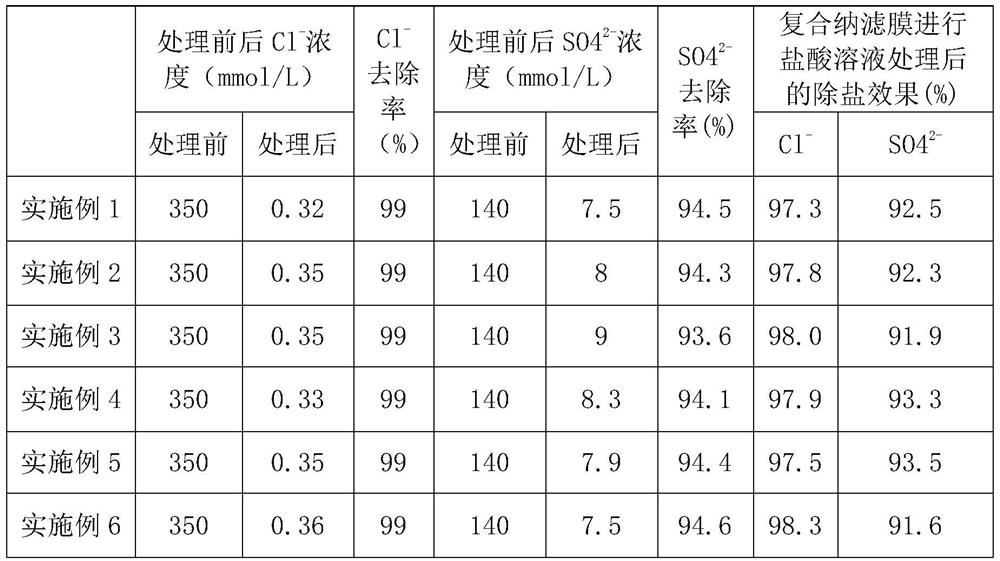Ink treatment method for digital inkjet printing
A digital inkjet and treatment method technology, applied in water/sewage treatment, multi-stage water/sewage treatment, textile industry wastewater treatment, etc., can solve the problems of membranes being easily polluted, short service life, and poor mechanical properties. Achieve the effects of not being easily polluted, excellent mechanical properties, and good solvent resistance
- Summary
- Abstract
- Description
- Claims
- Application Information
AI Technical Summary
Problems solved by technology
Method used
Image
Examples
specific Embodiment 1
[0042]S1: Ethyl tetrasilicate was dissolved in absolute ethanol, and dopamine hydrochloride and sodium citrate were dissolved in deionized water to prepare a mixed solution. Among them, the mass ratio of ethyl orthosilicate, dopamine hydrochloride and sodium citrate is 3:0.22:0.01. Add the mixed solution dropwise to the tetraethyl orthosilicate solution and stir at room temperature for 60 min, then add 0.1 mol / L hydrochloric acid solution, and then stir to prepare polydopamine-modified silica sol.
[0043] S2: adding the polydopamine-modified silica sol prepared in step S1 into a polyacrylonitrile-dimethylformamide solution, stirring and mixing to obtain a membrane liquid. DMF solution of polyethylene glycol was used as core fluid. The core liquid and the membrane liquid are respectively added into the core liquid channel and the membrane liquid channel of the dual-channel spinneret of the spinning machine, and the coagulation bath adopts deionized water to prepare the hollow...
specific Embodiment 2
[0048] S1: Ethyl tetrasilicate was dissolved in absolute ethanol, and dopamine hydrochloride and sodium citrate were dissolved in deionized water to prepare a mixed solution. Among them, the mass ratio of ethyl orthosilicate, dopamine hydrochloride and sodium citrate is 3:0.45:0.01. Add the mixed solution dropwise into the tetraethyl orthosilicate solution and stir at room temperature for 120 min, then add 0.1 mol / L hydrochloric acid solution, and then stir to prepare polydopamine-modified silica sol.
[0049] S2: adding the polydopamine-modified silica sol prepared in step S1 into a polyacrylonitrile-dimethylformamide solution, stirring and mixing to obtain a membrane solution. DMF solution of polyethylene glycol was used as core fluid. The core liquid and the membrane liquid are respectively added into the core liquid channel and the membrane liquid channel of the dual-channel spinneret of the spinning machine, and the coagulation bath adopts deionized water to prepare the ...
specific Embodiment 3
[0054] S1: Ethyl tetrasilicate was dissolved in absolute ethanol, and dopamine hydrochloride and sodium citrate were dissolved in deionized water to prepare a mixed solution. Among them, the mass ratio of ethyl orthosilicate, dopamine hydrochloride and sodium citrate is 3:0.25:0.01. Add the mixed solution dropwise to the tetraethyl orthosilicate solution and stir at room temperature for 70 minutes, then add 0.1 mol / L hydrochloric acid solution, and then stir to prepare polydopamine-modified silica sol.
[0055] S2: adding the polydopamine-modified silica sol prepared in step S1 into a polyacrylonitrile-dimethylformamide solution, stirring and mixing to obtain a membrane solution. DMF solution of polyethylene glycol was used as core fluid. The core liquid and the membrane liquid are respectively added into the core liquid channel and the membrane liquid channel of the dual-channel spinneret of the spinning machine, and the coagulation bath adopts deionized water to prepare the...
PUM
| Property | Measurement | Unit |
|---|---|---|
| pore size | aaaaa | aaaaa |
| particle diameter | aaaaa | aaaaa |
| specific surface area | aaaaa | aaaaa |
Abstract
Description
Claims
Application Information
 Login to View More
Login to View More - R&D
- Intellectual Property
- Life Sciences
- Materials
- Tech Scout
- Unparalleled Data Quality
- Higher Quality Content
- 60% Fewer Hallucinations
Browse by: Latest US Patents, China's latest patents, Technical Efficacy Thesaurus, Application Domain, Technology Topic, Popular Technical Reports.
© 2025 PatSnap. All rights reserved.Legal|Privacy policy|Modern Slavery Act Transparency Statement|Sitemap|About US| Contact US: help@patsnap.com

